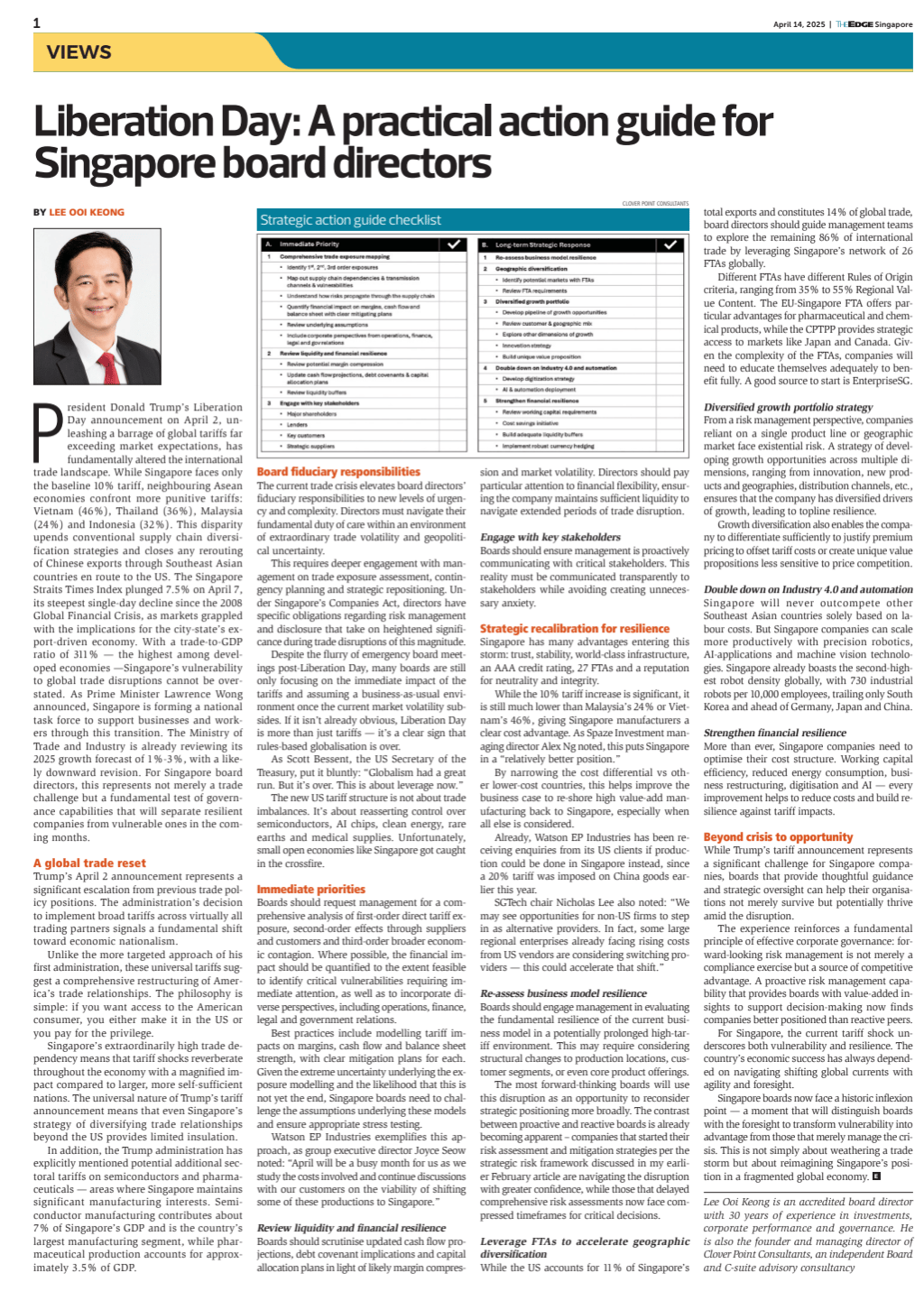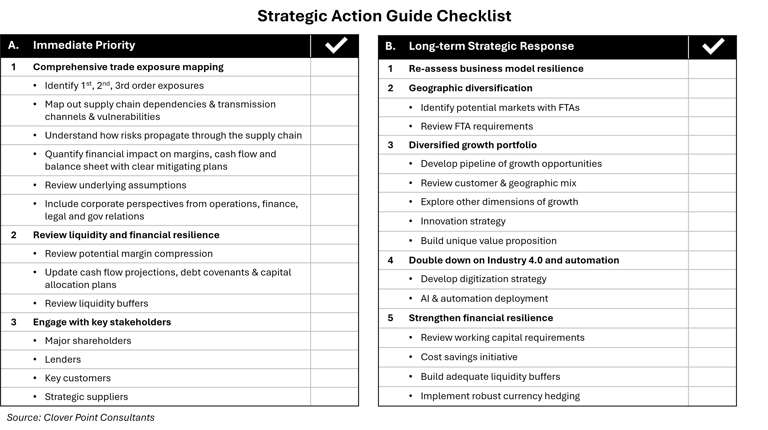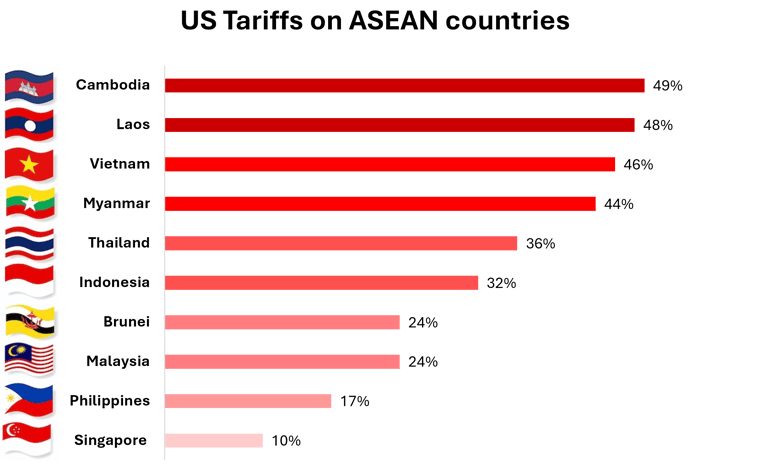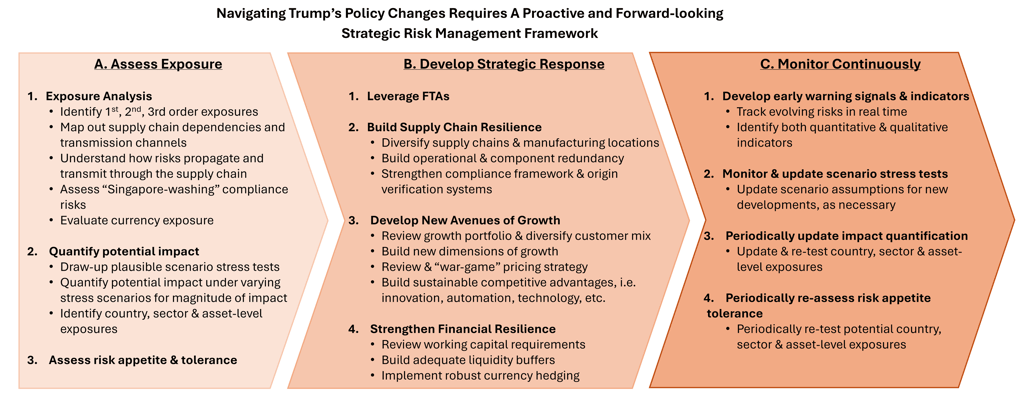Liberation Day: A Practical Action Guide for Singapore Board Directors
On 14 April 2025, the Edge Singapore featured my latest article Liberation Day: A Practical Action Guide for Board Directors


Liberation Day: A Practical Action Guide for Singapore Board Directors
President Trump's Liberation Day announcement on April 2, 2025, unleashing a barrage of global tariffs far exceeding market expectations, has fundamentally altered the international trade landscape.
While Singapore faces only the baseline 10% tariff, neighboring ASEAN economies confront more punitive tariffs: Vietnam (46%), Thailand (36%), Malaysia (24%), and Indonesia (32%). This disparity upends conventional supply chain diversification strategies and closes any rerouting of Chinese exports through Southeast Asian countries en route to the US.
The Singapore Straits Times Index plunged 7.5% on April 7, its steepest single-day decline since the 2008 global financial crisis, as markets grappled with the implications for the city-state's export-driven economy. With a trade-to-GDP ratio of 311%—the highest among developed economies—Singapore's vulnerability to global trade disruptions cannot be overstated.
As PM Lawrence Wong announced, Singapore is forming a national task force to support businesses and workers through this transition. The Ministry of Trade and Industry is already reviewing its 2025 growth forecast of 1-3%, with a likely downward revision.
For Singapore board directors, this represents not merely a trade challenge but a fundamental test of governance capabilities that will separate resilient companies from vulnerable ones in the coming months.
A Global Trade Reset
President Trump's April 2 announcement represents a significant escalation from previous trade policy positions. The administration's decision to implement broad tariffs across virtually all trading partners signals a fundamental shift toward economic nationalism. Unlike the more targeted approach of his first administration, these universal tariffs suggest a comprehensive restructuring of America's trade relationships.
The philosophy is simple: if you want access to the American consumer, you either make it in the US, or you pay for the privilege.
Singapore's extraordinarily high trade dependency means that tariff shocks reverberate throughout the economy with magnified impact compared to larger, more self-sufficient nations. The universal nature of Trump's tariff announcement means that even Singapore's strategy of diversifying trade relationships beyond the US provides limited insulation.
In addition, the Trump administration has explicitly mentioned potential additional sectoral tariffs on semiconductors and pharmaceuticals—areas where Singapore maintains significant manufacturing interests. Semiconductor manufacturing contributes about 7% of Singapore's GDP and is the country's largest manufacturing segment, while pharmaceutical production accounts for approximately 3.5% of GDP.
Board Fiduciary Responsibilities Amid Trade Volatility
The current trade crisis elevates board directors' fiduciary responsibilities to new levels of urgency and complexity. Directors must navigate their fundamental duty of care within an environment of extraordinary trade volatility and geopolitical uncertainty.
This requires deeper engagement with management on trade exposure assessment, contingency planning, and strategic repositioning. Under Singapore's Companies Act, directors have specific obligations regarding risk management and disclosure that take on heightened significance during trade disruptions of this magnitude.
Despite the flurry of emergency board meetings post-Liberation Day, many boards are still only focusing on the immediate impact of the tariffs and assuming a Business-As-Usual environment once the current market volatility subsides.
If it isn't already obvious, Liberation Day is more than just tariffs—it's a clear sign that rules-based globalization is over.
As Scott Bessent, the US Secretary of the Treasury put it bluntly, "Globalism had a great run. But it's over. This is about leverage now."
The new U.S. tariff structure is not about trade imbalances. It's about reasserting control—over semiconductors, AI chips, clean energy, rare earths, medical supplies.
Unfortunately, small open economies like Singapore got caught in the crossfire.
STRATEGIC ACTION GUIDE: IMMEDIATE PRIORITIES
Comprehensive Trade Exposure Mapping
Boards should request management for comprehensive analysis of 1st order direct tariff exposure, 2nd order effects through suppliers and customers, and 3rd order broader economic contagion. Where possible, the financial impact should be quantified to the extent possible to identify critical vulnerabilities requiring immediate attention, as well as incorporate diverse perspectives, including operations, finance, legal, and government relations.
Best practices include modeling tariff impacts on margins, cash flow, and balance sheet strength, with clear mitigation plans for each. Given the extreme uncertainty underlying the exposure modeling and likelihood that this is not yet the end, Singapore boards need to challenge the assumptions underlying these models and ensure appropriate stress testing.
Watson EP Industries exemplifies this approach, as Group Executive Director Joyce Seow noted: "April will be a busy month for us as we study the costs involved and continue discussions with our customers on the viability of shifting some of these production to Singapore."
Review Liquidity and Financial Resilience
Boards should scrutinize updated cash flow projections, debt covenant implications, and capital allocation plans in light of likely margin compression and market volatility. Directors should pay particular attention to financial flexibility, ensuring the company maintains sufficient liquidity to navigate extended periods of trade disruption.
Engage with Key Stakeholders
Boards should ensure management is proactively communicating with critical stakeholders. This reality must be communicated transparently to stakeholders while avoiding creating unnecessary anxiety.
LONG-TERM PRIORITIES: STRATEGIC RECALIBRATION FOR RESILIENCE
Singapore has many advantages entering this storm: trust, stability, world-class infrastructure, a AAA credit rating, 27 FTAs, and a reputation for neutrality and integrity.
While the 10% tariff increase is significant, it is still much lower than Malaysia's 24% or Vietnam's 46%, giving Singapore manufacturers a clear cost advantage.
As Spaze Investment managing director Alex Ng noted, this puts Singapore in a "relatively better position."
By narrowing the cost differential vs other lower-cost countries, this helps improve the business case to re-shore high value-add manufacturing back to Singapore, especially when all else is considered.
Already, Watson EP Industries has been receiving enquiries from its US clients if production could be done in Singapore instead since a 20% tariff was imposed on China goods earlier this year.
SGTech chair Nicholas Lee also noted: "We may see opportunities for non-US firms to step in as alternative providers. In fact, some large regional enterprises already facing rising costs from US vendors are considering switching providers—this could accelerate that shift."
Re-assess Business Model Resilience
Boards should engage management in evaluating the fundamental resilience of the current business model in a potentially prolonged high-tariff environment. This may require considering structural changes to production locations, customer segments, or even core product offerings.
The most forward-thinking boards will use this disruption as an opportunity to reconsider strategic positioning more broadly. The contrast between proactive and reactive boards is already becoming apparent – companies that started their risk assessment and mitigation strategies per the strategic risk framework discussed in my earlier February article are navigating the disruption with greater confidence, while those that delayed comprehensive risk assessments now face compressed timeframes for critical decisions.
Leverage FTAs to Accelerate Geographic Diversification
While the US accounts for 11% of Singapore's total exports and constitutes 14% of global trade, board directors should guide management teams to explore the remaining 86% of global trade by leveraging Singapore's network of 26 FTAs globally.
Different FTAs have different Rules of Origin criteria, ranging from 35% to 55% Regional Value Content. The EU-Singapore FTA offers particular advantages for pharmaceutical and chemical products, while the CPTPP provides strategic access to markets like Japan and Canada. Given the complexity of the FTAs, companies will need to educate themselves adequately to fully benefit. A good source to start with is EnterpriseSG.
Diversified Growth Portfolio Strategy
From a risk management perspective, companies reliant on a single product line or geographic market face existential risk. A strategy of developing growth opportunities across multiple dimensions, ranging from innovation, new products and geographies, distribution channels, etc., ensures that the company has diversified drivers of growth, leading to topline resilience.
Growth diversification also enables the company to differentiate sufficiently to justify premium pricing to offset tariff costs or create unique value propositions less sensitive to price competition.
Double-down on Industry 4.0 and Automation
Singapore will never outcompete other SEA countries solely based on labor cost. But Singapore companies can scale more productively with precision robotics, AI-applications and machine vision technologies. Singapore already boasts the second highest robot density globally with 730 industrial robots per 10,000 employees, trailing only South Korea and ahead of Germany, Japan and China.
Strengthen Financial Resilience
More than ever, Singapore companies need to optimize their cost structure. Working capital efficiency, reduced energy consumption, business restructuring, digitization and AI—every improvement helps to reduce costs and build resilience against tariff impacts.
Conclusion: Beyond Crisis to Opportunity
While President Trump's tariff announcement represents a significant challenge for Singapore companies, boards that provide thoughtful guidance and strategic oversight can help their organizations not merely survive but potentially thrive amid the disruption.
The experience reinforces a fundamental principle of effective corporate governance: forward-looking risk management is not merely a compliance exercise but a source of competitive advantage. A proactive risk management capability that provides boards with value-added insights to support decision making now finds companies better positioned than reactive peers.
For Singapore, the current tariff shock underscores both vulnerability and resilience. The country's economic success has always depended on navigating shifting global currents with agility and foresight.
Singapore boards now face a historic inflection point—a moment that will distinguish boards with the foresight to transform vulnerability into advantage from those that merely manage the crisis. This is not simply about weathering a trade storm but about reimagining Singapore's position in a fragmented global economy.
Written by:
Lee Ooi Keong
8 April 2025
Lee Ooi Keong is an accredited board director with 30-years of experience in investments, corporate performance and governance. He is also the founder and managing director of Clover Point Consultants, an independent Board and C-suite advisory consultancy.
If you like what you read, let’s connect & explore how to help your board navigate these trade challenges.








